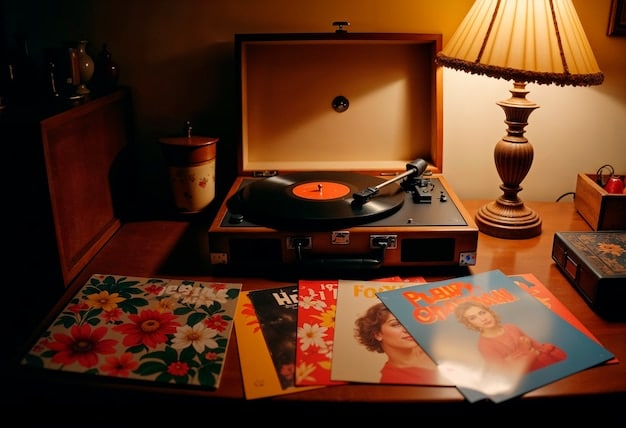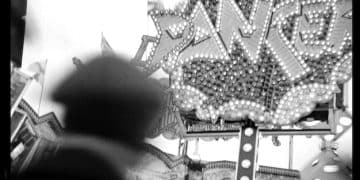International Cult Film Soundtracks: 10 Defining Albums

International cult film soundtracks feature unique and memorable music that enhances the film’s atmosphere, contributing significantly to its lasting impact and appeal to a dedicated fanbase.
The power of music in film is undeniable, and in the realm of cult cinema, soundtracks often transcend their role as mere background scores, becoming integral to the movie’s identity. These international cult film soundtracks not only amplify the on-screen action but also solidify the film’s place in cultural history. Join us as we explore ten albums that have defined a generation.
The Role of Soundtracks in Cult Cinema
Soundtracks play a crucial role in shaping the emotional landscape of a film, especially within cult cinema where originality and unique expression are highly valued. They’re not just background music; they’re sonic tapestries that enhance the narrative, evoke feelings, and deepen the audience’s connection to the story.
In cult films, music can become an essential element that defines the atmosphere, enhances the experience, and even creates iconic moments that stick with viewers long after the credits roll. Let’s explore why these soundtracks are so vital.
Enhancing the Film’s Atmosphere
A well-crafted soundtrack is capable of turning a good scene into an unforgettable one. By setting the mood, soundtracks deepen the emotional impact, making us laugh, cry, or shudder at just the right moments.
Creating Iconic Moments
Think of classic scenes synced perfectly with music – who can forget the iconic needle drop in “Pulp Fiction” or the chilling theme from “Halloween”? These musical moments etch themselves into our memories, forever linking the visuals with their auditory counterparts.

Soundtracks as Cultural Artifacts
Cult film soundtracks often take on a life of their own. They may introduce listeners to obscure artists, revive forgotten genres, or become symbols of the film’s unique subculture. The soundtracks, acting as cultural touchstones, connect with the people who cherish the film.
- Influence on Fashion: The music can inspire clothing trends and style choices.
- Impact on Language: Memorable lines from the music merge into everyday conversation.
- Artistic Inspiration: Other artists frequently draw inspiration from the soundtrack’s themes and sounds.
The success and impact of a film can hinge greatly on its soundtrack, especially in the niche world of cult cinema where originality and atmosphere are key.
Ennio Morricone – “Once Upon a Time in the West” (1968)
Ennio Morricone’s score for “Once Upon a Time in the West” is a defining example of how music can elevate a film to legendary status. His unique blend of orchestral arrangements and distinctive leitmotifs created an emotionally resonant experience.
This soundtrack is more than just background music; it’s a character in itself, enhancing the drama, romance, and tension of Sergio Leone’s epic Western.
Thematic Resonance
Each character has a distinct theme, which not only accompanies them but also foreshadows their fate. This method builds tension and emotional depth throughout the movie.
Innovative Instrumentation
Morricone masterfully uses instruments to evoke the rugged landscape and the moral complexities of the Wild West. The use of harmonica, electric guitar, and haunting vocals adds to the musical narrative.
The soundtrack’s lasting impact is evident in countless films, TV shows, and commercials that have drawn inspiration from its distinctive sound. Morricone’s legacy continues to influence composers across the globe.
Vangelis – “Blade Runner” (1982)
Vangelis’s electronic score for “Blade Runner” is an atmospheric masterpiece. It perfectly captures the dystopian future of Ridley Scott’s sci-fi noir, creating an immersive sonic landscape.
The music harmonizes with the visual elements of the film, creating a synergy that enhances the futuristic and melancholic mood. Let’s delve into what makes this soundtrack so iconic.
Futuristic Atmosphere
Vangelis employed synthesizers and electronic instruments to create a soundscape that matched the film’s futuristic setting. This sound effectively conveyed the high-tech, low-life existence envisioned in “Blade Runner.”
Emotional Depth
Despite its electronic nature, the score conveys a deep sense of humanity and emotion. Tracks like “Tears in Rain” evoke empathy for the replicants and add a philosophical dimension to the film’s themes.

The “Blade Runner” soundtrack stands as a testament to the fusion of technology and artistry, inspiring countless electronic musicians and filmmakers alike.
Tangerine Dream – “Sorcerer” (1977)
Tangerine Dream’s score for “Sorcerer” is a haunting and atmospheric journey into the heart of darkness. The German electronic band’s blend of synthesizers and progressive rock creates a suspenseful mood.
The soundtrack perfectly complements William Friedkin’s intense thriller, increasing the on-screen tension. Let’s explore its unique characteristics.
Suspenseful Mood
The electronic music enhances the film’s suspense, with its haunting melodies and rhythmic pulses. These sounds plunge viewers into the characters’ dangerous and uncertain world.
Progressive Rock Elements
Tangerine Dream mixes progressive rock elements with electronic music to produce a sound that mirrors the tough experiences and inner conflicts. Layers of synths and guitars intensify the emotional impact of the scenes.
- Synthesizer Soundscapes: Creating eerie and dreamlike environments.
- Driving Rhythms: Reflecting the constant movement and danger faced by the characters.
- Emotional Melodies: Enhancing the human elements within the thriller.
The “Sorcerer” soundtrack remains a landmark in electronic film scoring, demonstrating Tangerine Dream’s ability to craft immersive and memorable musical landscapes.
Goblin – “Suspiria” (1977)
Goblin’s score for “Suspiria” is an assault on the senses, a cacophony of frightening sounds and unsettling melodies. The Italian progressive rock band’s work is a defining element of Dario Argento’s horror classic.
Every note of this soundtrack is designed to unsettle and terrify: it adds to the film’s terrifying ambiance. Let’s analyze how Goblin’s music improves the movie’s effect.
Horror Elements
Goblin used screaming vocals, dissonant harmonies, and odd percussion to create an unnerving listening experience. Every noise is designed to amplify the tension and fear.
Progressive Rock Influence
The band’s progressive rock background is evident in the complex arrangements and instrumental prowess. These factors help to create an unpredictable and frightening musical landscape.
The “Suspiria” soundtrack is a benchmark in horror film scoring, demonstrating the profound impact of music in eliciting fear and unease.
Ry Cooder – “Paris, Texas” (1984)
Ry Cooder’s slide guitar score for “Paris, Texas” is both haunting and heartbreaking, conveying the isolation and profound sense of loss at the core of Wim Wenders’ drama.
Cooder’s score mixes perfectly with the film’s visual beauty, deepening the audience’s emotional connection. Let’s analyze what makes the music so touching.
Slide Guitar
The use of slide guitar creates a distinct sound, evoking the loneliness and vastness of the Texas landscape. Every note reflects the protagonist’s emotional difficulties.
Emotional Resonance
The soundtrack mirrors the film’s themes of identity, memory, and redemption through simple yet powerful melodies. This resonance enhances the profound emotional experience for viewers.
- Evocative Melodies: Creating a sense of yearning and nostalgia.
- Sparse Arrangements: Allowing the emotions to take center stage.
- Landscape Connection: Reflecting the vastness and desolation of the Texas setting.
The “Paris, Texas” soundtrack stands as a monument to the ability of music to express profound feelings, making a lasting impact.
Various Artists – “Repo Man” (1984)
The “Repo Man” soundtrack is a punk rock feast, capturing the edgy spirit of Alex Cox’s cult classic. Featuring tracks by Iggy Pop, Black Flag, and the Circle Jerks, this compilation is energetic.
The songs, which convey rebellion and nonconformity, are in sync with the movie’s atmosphere. Let’s explore how the soundtrack highlights the film’s punk culture.
Punk Rock
The soundtrack features punk rock and hardcore punk from prominent bands of the era. This is reflective of the era’s youthful energy.
Thematic Cohesion
The themes of rebellion, alienation, and anti-establishment sentiment tie well with the film’s story. The songs add to the film’s rebellious spirit.
The “Repo Man” soundtrack embodies the punk ethos, solidifying its cult status by perfectly encapsulating the film’s anti-establishment message.
Isaac Hayes – “Shaft” (1971)
Isaac Hayes’s score for “Shaft” is a masterpiece of blaxploitation cinema, defining the genre with its funky rhythms, wah-wah guitars, and Hayes’s own soulful vocals. The soundtrack is a mix of funk, soul, and orchestral elements.
The music increases the film’s gritty setting and character identity. Let’s look at what distinguishes this score.
Funk and Soul
Hayes incorporated the key characteristics of funk and spirit into the song, including driving basslines, percussion, and soulful arrangements. These sounds are ideal for the film’s urban setting.
Character Theme
The “Theme from Shaft” is a catchy and iconic tune that introduces the character and establishes the film’s tone. It has become one of the most recognizable movie themes of all time.
The “Shaft” soundtrack not only defined an era but also set a high watermark for film scoring. Its influence continues to resonate in music and film today.
Riz Ortolani – “Cannibal Holocaust” (1980)
Riz Ortolani’s score for “Cannibal Holocaust” is a surprising blend of beautiful melodies and unsettling undertones, creating a strange contrast. The soundtrack goes unexpectedly well with the film’s graphic images.
The dichotomy deepens the film’s impact despite its disturbing scenes. Let’s explore how Ortolani’s music works.
Contrasting Themes
The score contrasts scenes of extreme violence with gentle, beautiful melodies to create a chilling effect. This dichotomy enhances the film’s shock value.
Emotional Impact
The haunting melodies add an odd dimension to the film, making viewers consider the humanity amid the brutality. This method elevates the picture beyond simple shock value.
The “Cannibal Holocaust” soundtrack remains a polarizing but memorable work, demonstrating the power of music to evoke strong emotions.
Angelo Badalamenti – “Twin Peaks: Fire Walk with Me” (1992)
Angelo Badalamenti’s score for “Twin Peaks: Fire Walk with Me” is a dreamy and haunting exploration of the dark side of David Lynch’s world. The soundtrack is eerie, atmospheric, and deeply emotional.
The music is reflective of the series’ and film’s strange and mysterious atmosphere. Let’s explore its defining features.
Atmospheric Soundscapes
Badalamenti creates a surreal and dreamlike setting with ambient sounds and ethereal melodies. These soundscapes enhance the film’s feeling of unreality.
Emotional Depth
The music conveys sadness, fear, and longing. It adds to the intensity of the complex emotional themes in the film. The songs connect strongly with the audience, heightening their experiences.
- Dreamy Melodies: Contributing to the film’s surreal atmosphere.
- Haunting Harmonies: Enhancing the feeling of dread and suspense.
- Emotional Resonance: Amplifying the connection to the characters’ inner turmoil.
The “Fire Walk with Me” soundtrack is a testament to Badalamenti’s artistry, solidifying its position as a cult classic piece of art.
Clint Mansell – “Requiem for a Dream” (2000)
Clint Mansell’s score for “Requiem for a Dream” is as unsettling and emotionally draining as the film itself. The soundtrack mixes strings, electronic components, and repeating melodies to create tension.
The music mirrors the film’s themes of addiction, desperation, and loss as a result. Let’s analyze the features that define the score.
Intense Tension
The repeating arrangements and building intensities create a feeling of impending doom. The tension heightens at every point of the film.
Emotional Impact
The score conveys the agony and despair experienced by the characters, prompting a sense of empathy and understanding from viewers. The music heightens the film’s emotional power.
Key Highlights
Key points and their summations.
| Key Point | Brief Description |
|---|---|
| 🎵 Iconic Soundtracks | Soundtracks enhance film atmosphere, creating cultural artifacts. |
| 🎻 Ennio Morricone | “Once Upon a Time in the West” features thematic resonance and innovative instrumentation. |
| 🤖 Vangelis’s “Blade Runner” | Electronic music creates a futuristic, emotional soundscape. |
| 🎸 “Repo Man” | Punk rock soundtrack captures the film’s edgy spirit. |
Frequently Asked Questions
▼
Soundtracks help define the atmosphere, increase emotional impact, and establish the film’s identity, eventually solidifying the film’s cultural impact, and increasing the connection with the audience.
▼
A cult soundtrack appeals strongly to a niche audience and sets the mood and elevates memorable moments. In addition, influential music may provide the cult status.
▼
Tracks set the tone, heighten emotional intensity, and enhance scenes, making them vivid and memorable. Melodies may convey themes and feelings that go well with the on-screen actions.
▼
They introduce or revive genres, reflect subcultures, and inspire popular culture, impacting language, fashion, and art, gaining a devoted following and long-lasting significance.
▼
Cult film soundtracks may impact standard culture by affecting how people perceive a film. They can alter trends in art, and language, and may also be incorporated into other films.
Conclusion
These ten **international cult film soundtracks** not only defined a generation but also highlighted the enduring impact of music in cinema. These albums have captured the hearts and minds of film and music enthusiasts. They have enhanced classic films to another level by evoking powerful sensations.





